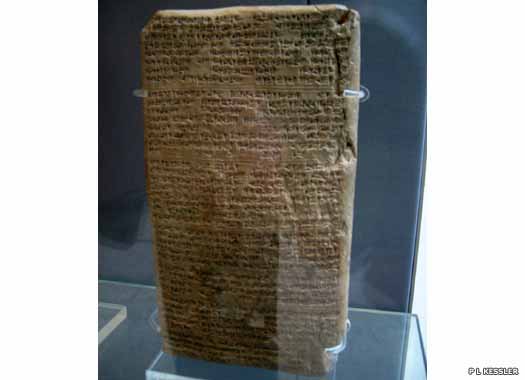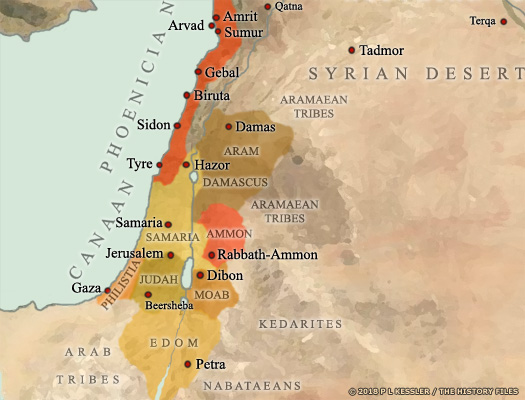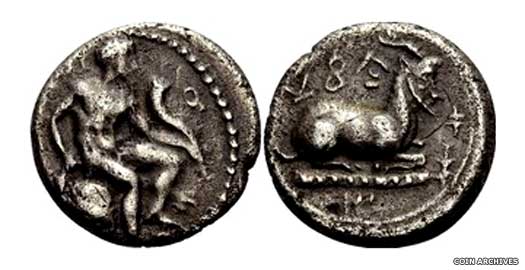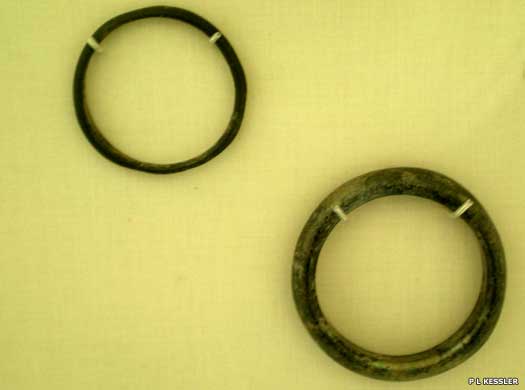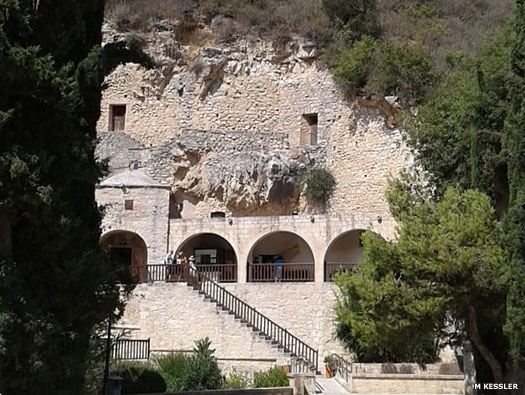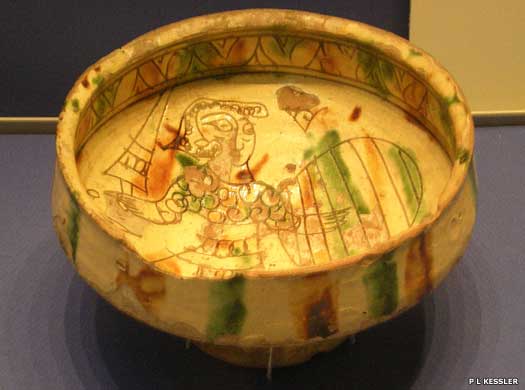
| CYPRUS The island of Cyprus has spent much of recorded history being occupied by various major powers. Today its independent republic of Cyprus governs two-thirds of an island which is largely peaceful after a tense and destabilising period in the last quarter of the twentieth century - in which it was invaded and partially occupied once again. The island is neighboured across the waters of the Mediterranean by Turkey to the north, Syria to the east, Lebanon and Israel to the south-east, Egypt to the south, and the islands of Greece (especially Crete and Rhodes) to the west.
According to archaeological investigation and limited conjecture, Early Cyprus developed in stops and starts throughout the Neolithic and Bronze ages in Europe. The Cypriots had an advanced, Indo-European civilisation by the middle of the second millennium BC, one which eventually developed a written language thanks to later additional influences. The first Mycenaean colony is believed to have been founded by traders from Arcadia about 1400 BC, but Mycenaean culture appeared at least two centuries before that. In subsequent centuries, seafaring and trading peoples from the Mediterranean countries set up scattered settlements along the coast.
The recorded history of Cyprus began with the occupation of part of the island by Egypt. The Phoenicians began to colonise areas of the island from about 800 BC. Beginning with the rise of Assyria during the eighth century BC, Cyprus was under the control of each of the empires that successively dominated the eastern Mediterranean. Assyrian authority was followed by that of Egypt (again), and then of Persia. For almost a thousand years thereafter control of the island passed from empire to empire until a Crusader kingdom was set up in the twelfth century AD.
(Information by Peter Kessler, with additional information from Digging up the Tombs of the Kings, Sophocles Hadjisavvas (2014), from Ancient Israel and Its Neighbours: Interaction and Counteraction. Collected Essays Vol 1, Nadav Na'aman, from The Cambridge Ancient History, edited by I E S Edwards, from The Persian Empire, J M Cook (1983), from Civil-military relations, nation building, and national identity: comparative perspectives, Constantine Panos Danopoulos (Greenwood Publishing Group, 2004), from Cyprus: Reunification Proving Elusive, Vincent Morelli (Diane Publishing, 2011), and from External Links: Encyclopędia Britannica, and History Extra, and World Statesmen.)
Kingdom
of Alashiya / Alasiya (Enkomi) (Late Bronze Age) :
The eastern Cypriot state of Alashiya (or Alasiya) appeared by the mid-fifteenth century BC, during the Late Bronze period on the island. It had a capital at Enkomi, immediately to the north-west of the modern port of Famagusta, approximately three kilometres (two miles) inland. Evidence points to it having controlled the entire island during at least part of its existence. A contributor to the Amarna letters, it played an important role in trade with the great states of the period, the Hittites, Mitanni, Egypt, Babylon and Elam, with goods being shipped from a prosperous port protected by massive stone walls. At least one of its rulers was counted amongst the great kings of the day, mainly because the island controlled the region's copper trade - vital to all the major states. Its coastline was subjected to various raids, however, notably by the tribal Lukka, and later by the Hittites.
(Additional information from Ancient Israel and Its Neighbours: Interaction and Counteraction. Collected Essays Vol 1, Nadav Na'aman, and from The Cambridge Ancient History, edited by I E S Edwards.)
c.1430s BC :
Arzawa concludes a treaty with the Hittite king, Tudhaliya II (I). However, according to an internal Hittite memo, the 'Indictment of Madduwattas', by Tudhaliya's heir, Arnuwanda I, one Madduwattas appears to be in regular conflict with Kupanta-Kurunta from his Hittite-supported mountain kingdom of Zippasla in western Anatolia.
Regularly defeated by the Arzawan king, a Hittite army is moved into Zippasla to provide a permanent garrison. With the kingdom at last secure against Kupanta-Kurunta, Madduwattas apparently now decides that he is never again going to suffer such indignities as his many defeats. When Dalawa (Tlawa of the Lukka, classical Tlos) and Hinduwa rebel, Madduwattas suggests to the Hittite army commander, Kisnapili, that he takes Hinduwa while Madduwattas takes Dalawa. But while Kisnapili is on his way to Hinduwa, Madduwattas allies himself to Dalawa and, with its help, he ambushes and kills Kisnapili.
Subsequently he marries the daughter of Kupanta-Kurunta of Arzawa and then wins the Arzawan throne itself (the circumstances are unclear). Then he moves his capital into Arzawa proper and enlarges this state in its western Anatolian holdings. When Tudhaliya orders Madduwattas to put down a revolt in Happalla, he does so, but then forces Happalla to switch its loyalty to him. Then he bullies Pitassa into his kingdom, which brings Arzawa's borders even closer to the Hittite heartland. Under Tudhaliya's hapless successor, Arnuwandas I, Madduwattas even allies himself to his old foe, Attarsiyya of Ahhiyawa, and invades Alashiya. Madduwattas now holds the whole of western Anatolia.
fl 1430s BC :
Madduwattas : Defeated by Ahhiyawa. Fled to Hittites. Contested for Arzawa.
c.1420s BC :
Attarsiyya of Ahhiyawa conquers Alashiya for himself, re-igniting the enmity between him and Madduwattas. The latter flees back to Anatolia, leaving the island of Cyprus briefly in Ahhiyawan hands. The Hittites under Arnuwanda soon take Alashiya for themselves however, but for how long they hold it is unknown.
c.1370s BC :
The Lukka are mentioned in the Armana letters from Egypt, in which they are accused of attacking the Egyptians in conjunction with the Alashiyans. In their defence the latter state that the Lukka are seizing their villages.
fl 1360s BC :
? : Name unknown. The king refers to himself as the 'brother' of the Egyptian king in the Amarna letters, revealing the fact that he is considered to be a ruler of equal standing (and not literally his brother). The clay in the Amarna tablets that are sent by the Alashiyan king is a good match for that of Cyprus, further tying the kingdom to the island (a subject that had been a matter of some debate right up until the end of the twentieth century).
The clay used to make tablets for those of the Amarna letters that were sent from Alashiya contained clay that can be matched closely to deposits on Cyprus c.1250? BC :
Later Hittite kings invade the kingdom and establish pro-Hittite rulers, but they never fully control the island. The harbour town of Bamboula thrives from this period until the eleventh century. It sits along a highway on the outskirts of the modern village of Episkopi, along the south-western coast of Cyprus and near the modern harbour town of Limassol. The area thrives in part because the overshadowing Troodos Mountains contain copper, and the river below is used to transport the mined materials. A nearby fortress may function to protect the urban economic centre further inland, which does not seem to be fortified.
fl c.1250 BC :
? : Hittite vassal. Name(s) unknown.
1200 - 1195 BC :
The Hittite empire is destroyed by the Kaskans and the Sea Peoples. Other important Hittite cities, such as Emar, also disappear after a period of troubles which are characterised by attacks by seaborne raiders. There may be a severe attack on Ugarit around 1195 BC, as some sources date this as the city's last days.
fl c.1182 BC :
Eshuwara : King, or high steward/grand supervisor.
c.1182 BC :
The king of Alashiya advises Ugarit to defend itself in the face of continuing attacks on Syria by the Sea Peoples. The advice comes too late and, with Ugarit's fleet away and probably lost, many sites in Alashiya are also sacked and burned, including Enkomi, Kition, and Sinda (perhaps twice) before being abandoned. A number of other sites are also abandoned, leaving behind hidden caches of wealth which suggest that their owners are enslaved or killed. This event separates the Late Cypriot (LC) II period from the LCIII period. However, despite this setback, the state is one of the few to actually recover and prosper during this period, perhaps due to the removal of Mycenaean dominance in the region. There is increased urban expansion and metal production, improved contacts with Egypt, the Levant, and the central Mediterranean.
fl c.1050 BC :
Hatiba : A local queen, mentioned by Wenamun. The kingdom is mentioned in the Chronicle of Wenamun, an eleventh-century Egyptian priest who journeys throughout the Levant. His vessel is blown off course between Byblos and Egypt, and when stepping foot on the island he records that he is almost killed by an angry mob, before being rescued by the town's 'princess', Habti.
When the Neo-Assyrian empire threatened the various city states of southern Syria and Canaan around 853 BC, they united to protect their joint territory - successfully it seems, at least for a time 774 - 750 BC :
The Phoenician city state of Tyre founds a trading colony on Cyprus called Kition (Latin Citium, or modern Larnaca which is nearby the site). The site had originally been founded as Kittim by Mycenaeans for copper mining purposes in the thirteenth century BC, but this had died out around two centuries later. It is the Phoenician settlement that creates a permanent town. Its sea port becomes a major trading centre until it is destroyed by an earthquake in AD 332. This date also marks the end of the Cypro-Archaic I period.
709 - 669 BC :
The king of Tyre, Elulaios, petitions Sargon the Great, claiming that the kings of Cyprus are not paying the tribute that he feels he is owed. As a result, it seems that the Assyrian empire conquers the island for this reason alone. Assyrian inscriptions refer to Cyprus as Yadnana or Adnana. Three other inscriptions mention Sargon either in the third or first person (the translation is flexible) as the 'subduer of the seven kings of the land of Ia, a district of the land of Yadnana'. The use of 'seven kings' may be a stock phrase learned by the scribes during their schooling, and the individual names are not mentioned.
670s BC :
There are ten vassal kings of Yadnana in this decade, shortly before it reclaims its independence, as detailed in the annals of Esarhaddon of Assyria. These vassals all participate in the building of the royal palace at Ninevah, although Assyria's control of the island is purely for profit and is fairly distant. Tribute is collected either by a resident overseer at Kition, the main Tyrian port, or by visiting representatives. No Assyrian-influenced artefacts ever seem to be erected on the island.
fl c.670s BC :
? : Assyrian vassal king of Idalium (Assyrian Edi-al).
fl c.670s BC :
? : Assyrian vassal king of Chytri (Assyrian Kitrusi).
fl c.670s BC :
? : Assyrian vassal king of Salamis (uncertain)? (Assyrian Sillūa).
fl c.670s BC :
? : Assyrian vassal king of Paphos (Assyrian Pappa).
fl c.670s BC :
? : Assyrian vassal king of Soli (Assyrian Sillu).
fl c.670s BC :
? : Assyrian vassal king of Curium (Assyrian Kurī).
fl c.670s BC :
? : Assyrian vassal king of Tamassus (Assyrian Tamesu).
fl c.670s BC :
? : Assyrian vassal king of Ledrae (Assyrian Lidir).
fl c.670s BC :
? : Assyrian vassal king of ? (Assyrian Nure).
fl c.670s BC :
? : Assyrian vassal king of ? (Assyrian Kartihadast = New City).
Three of the kings are probably Pylagoras (uncertain, from the Assyrian Pilāgura), Eteander (almost fully certain, from Itūandar), and Damasus (from Damasu).
550 BC :
Egypt re-occupies the island after the Assyrian collapse. Client kings continue to govern the city state of Salamis.
Kingdom of Salamis :
The Cypriot city of Salamis was to the immediate north of modern Famagusta, on the eastern coast, with the city state kingdom legendarily being founded by Teukros. Most of the client kings of this and the other Cypriot cities are relatively poorly documented. The first of them for Salamis (or at least the earliest-known) may have existed around the 670s BC, but the translation of an Assyrian inscription to produce the name Salamis is extremely uncertain and open to much deliberation.
During the late fifth century Persian occupation, Evagoras, pro-Hellenic ruler of the Cypriot city of Salamis, made the first recorded attempt to unify the many city states of Cyprus. In 391 BC Evagoras, with the aid of Athens, led a successful revolt against Persia and temporarily made himself master of the island. However, Cyprus soon became a Persian possession again.
(Additional information from Digging up the Tombs of the Kings, Sophocles Hadjisavvas (2014), from The Persian Empire, J M Cook (1983), and from External Links: Encyclopędia Britannica, and History Extra.)
Teukros : Legendary founder of Salamis.
525 BC :
The Persians conquer Egypt in 525 BC, creating the 27th Dynasty, although according to the Behistun inscription of Darius the Great it is known to the Persians as Mudraya. Gaining Egypt also meant gaining Cyprus, as it seems to have been under Egyptian control for the previous half century. In fact, Herodotus mentions the Cypriots submitting voluntarily and sending ships to aid Cambyses. The Achaemenids also gains a host of Greek islands which are known collectively to them (as recorded on the Behistun inscription) as Yauna (Ionia to the Greeks).
fl c.525 BC :
Siromos : Persian vassal.
fl c.515 BC :
Hersis : Persian vassal.
500 - 499 BC :
Gorgos : Persian vassal. Removed from office during the Ionian Revolt.
499 - 498 BC :
Onysilos : In revolt against Persia.
499 - 494 BC :
The Ionian Greeks of western Anatolia and the islands of the eastern Aegean who are under Persian hegemony now rise in the Ionian Revolt. The Carians join in and, with the Ionians being led by Aristagoras, tyrant of Miletus, they inflict heavy losses on the Persians. Similar revolts arise in Aeolis, Salamis, and Doris as the Greeks see a chance for freedom. Athens sends troops to aid the Ionian islands but the Persians gradually gain the upper hand and the revolt crumbles. Cyprus is taken about a year after joining the revolt and Gorgos is restored to his position as ruler of Salamis.
498 - 480 BC :
Gorgos : Restored, and later declared independence from Persia.
480 - 479 BC :
Invading Greece in 480 BC, the Persians subdue the Thracian tribes, and they join his forces, all except the Satrai, precursors to the Bessoi, who refuse to succumb. The Macedonians are also subdued but continue to supply aid in the war against the Persians. Then the vast army of the Persian King Xerxes makes its way southwards and is swiftly engaged by Athens and Sparta in the Vale of Tempe. The Persians are subsequently stymied by a mixed force of Greeks led by Sparta at Thermopylae. (These events are depicted somewhat colourfully - but no less impressively for that - in the 2007 film, 300.)
Athens, as the leader of the coalition of city states known as the Delian League, then defeats the Persian navy at Salamis, and after Xerxes returns home, his army is decisively defeated at the Battle of Plataea and kicked out of Greece. (The naval battles of Artemisium and Salamis are shown to superb graphic effect in the 2014 sequel film, 300: Rise of an Empire, although it does contain a great many historical inaccuracies.)
480 - 465 BC :
Philaon : Freed of Persian vassalage in 478 BC.
Nicodemus
465 - 450 BC : Lacharidas
fl c.450 BC :
Eventhes
? - c.415 BC :
? : Name unknown, and of Phoenician origin.
c.415 BC :
The Phoenician ruler of Salamis is killed by Abdemon, who subsequently rules both Salamis and Tyre. Evagoras, who is a Cyprian Greek, is forced to leave the island at the same time, heading into exile on Soloi.
c.415 - 411 BC :
Abdemon / Avdimon : King of Salamis & Tyre. Of Phoenician origin. Deposed.
411 BC :
Evagoras returns to Salamis with his followers and deposes Abdemon. As a descendant of the island's old Greek royal family which claims descent from Ajax' brother, Teucer, Evagoras is a worthy candidate. He declares independence from Persia and unifies Cyprus. He also retains control of the Phoenician city of Tyre.
Shown here are the two sides of a silver coin which was issued by the Cyprian Greek King Evagoras during his Athenian-supported rebellious reign of Salamis 411 - 374 BC :
Evagoras / Eugoras I : King of Salamis & Tyre.
c.410 BC :
The city state of of Amathus has been independent since about 450 BC, with at least one unknown king prior to Timonax. Located on the south coast near modern Limassol, it is now absorbed by Salamis.
381 - 374 BC :
Evagoras miscalculates his advantage in a naval battle against the Persians, and the commander, Glos, wins a great victory. Persia effectively regains control of Cyprus in 381 BC after ten years of effort, and Salamis is besieged. Evagoras sues for peace (probably in 380 BC) and manages to negotiate a continuation of his position as (client) king of Salamis, apparently also continuing to rule the entire island. In 374 BC he is murdered by a eunuch who is seeking revenge for personal reasons. From this point, the city of Amathus is given its own governors.
374 - 368 BC :
Nikocles
368 - 351 BC :
Evagoras II : King of Salamis. Later in Sidon (346-343 BC).
351 BC :
Very shortly after his accession as dynastic satrap of Karkā, Idrieus is required to assemble troops for an invasion of Cyprus. Once again the Cypriot king has rebelled against Persian authority. Despite not quite having the iron nerve of his late brother, Idrieus and an Athenian general work together to stifle the uprising. Evagoras II is removed from Salamis but appears briefly around five years later as a king of Sidon, possibly as a Persian-controlled stopgap during an interregnum.
351 - 332 BC :
Pnytagoras
334 - 333 BC :
Pamphylia in Anatolia is conquered by Alexander the Great's Greek empire. A friend of Alexander, Nearchus is appointed satrap of Lycia and Pamphylia in 333 BC, being responsible for the ports in southern Anatolia. This forces the Persian navy to sail across open waters between Cyprus and the Aegean Sea. The Persian commanders Memnon of Rhodes and Pharnabazus are active in Aegean waters in 333 BC but receive no reinforcements, possibly due to Nearchus' efforts.
332 - 310 BC :
Alexander the Great forces take control of Cyprus, although the island's various client kings are retained, including Pnytagoras. The sub-king provides Alexander with great service in naval actions before the city of Tyre. His own quinquereme is sunk during the action, although he survives and is granted an extension of his kingdom as a result.
331 - 310 BC :
Nicocreon : Son. Forced to commit suicide by Ptolemy I of Egypt.
312 BC :
The town of Marion is destroyed by Ptolemy Soter, and the population is transferred to the recently-founded city of Pafos. The growth of the city and the erection of its fortifications, a direct consequence of the events that follow the death of Alexander the Great, are instrumental to the removal of cemeteries to some distance outside the walls.
310 - 306 BC :
Menelaos : Last king of Salamis, claimed independence during Greek wars.
306 - 301 BC :
Cyprus falls under the control of the Antigonids. When Antigonus is killed at the end of the Fourth War of the Diadochi, the island again becomes an Egyptian possession, under the Ptolemies of Egypt.
The port city of Nea or New Pafos, founded either by Nikocles or Nicocreon (sources seem confused) and sometimes given a date of 320 BC, now becomes the seat of government, replacing Salamis thanks to its good harbour and easy access to Alexandria. It is here that the Ptolemies install a strategos (governor-general) who rules on their behalf. serving as commander-in-chief, high priest, and admiral of the fleet. A circle of non-Cypriots close to the royal family govern the island from the luxury villas and administrative centres of Nea Paphos. In time they come to be buried in the great rock-cut cemeteries that spread out from the city walls, put to rest in great atrium-style house tombs just like those found in Alexandria and Cyrene.
170 - 168 BC :
Antiochus IV of the Seleucid empire mounts a pre-emptive attack on Egypt, triggering the Sixth Syrian War. Pelusium is taken after the first battle and much of Egypt is occupied in 169 BC. Urged on by the citizens of Alexandria, the siblings of Ptolemy VI of Egypt - Ptolemy VII and Cleopatra II - form a rival government. Ptolemy VI joins them and the war is re-ignited. Early in 168 BC, Antiochus captures Cyprus from them and re-invades Egypt, but Rome orders Antiochus out of Egypt. Humiliated, he does so, but maintains his territorial holdings outside of Egypt.
Macedonian (Ptolemaic) Cyprus :
132 - 131 BC :
Cleopatra
II makes the most of an Alexandrine revolt against her cousin-husband,
Ptolemy Euergetes. he and Cleopatra III flee to Cyprus while she
is left in sole command in Egypt. Ptolemy Memphitis is the son of
both parties, named after the location of his birth. He is proclaimed
pharaoh by Cleopatra II. Ptolemy Euergetes still manages to have
him killed and cut into quarters, with the remains being sent to
Cleopatra. Civil war ensues, along with a general collapse of central
government.
? - 116 BC :
Philometer Soter / Ptolemy IX : Egyptian governor of Cyprus. Became co-ruler in Egypt.
116 BC :
The death of Ptolemy Euergetes ends a highly eventful and unsettled period of Ptolemaic history in Egypt. His nominated successors are Cleopatra III and one of her sons, with the choice of which of them being hers. She prefers the younger of them, Alexander, but the Alexandrines want Philometer Soter, current governor of Cyprus. She reluctantly complies, and Philometer becomes Ptolemy IX, while Alexander takes his place on Cyprus.
116 - 114 BC :
Ptolemy X Alexander I : Egyptian governor of Cyprus. Involved in Seleucid civil war.
115 - 113 BC :
Antiochus IX, a son of Cleopatra Thea and her marriage to Antiochus VII, attempts to seize the Seleucid throne. He gains an army in 115 BC when he marries Cleopatra IV, who has just learned that her husband, Ptolemy Soter, has divorced her. He revolts against his half-brother, occupying southern Syria. In 112 BC Antiochus VIII defeats his opponents, and Cleopatra IV is captured and killed. However, later in the same year Antioch is again in the hands of Antiochus VIII. Both Seleucid rulers now find allies (or further allies) in Egypt, with Antiochus VIII being joined by Ptolemy Alexander, governor of Cyprus, and Antiochus IX being supported by Ptolemy Soter Lathyros.
114 - 107 BC :
Ptolemy X Alexander I : Restored as governor? Co-ruler in Egypt (110-109 BC).
107 - 89 BC :
Ptolemy IX Soter II Lathyros : Egyptian governor of Cyprus. Co-ruler in Egypt (109-107/88-81 BC).
89 - 88 BC :
With Ptolemy Soter being restored as co-ruler of Egypt by Cleopatra III, Cyprus remains under his command as governor until Ptolemy Alexander succeeds him on the island.
88 BC :
Ptolemy X Alexander I : Retook control. Co-ruler in Egypt (107-88 BC). Killed in battle.
88 - 80 BC :
Cyprus is seemingly controlled directly by Egypt during the restored reign of Ptolemy IX Lathyros. His death in 81 BC sees him succeeded by his daughter, Berenice III. In 80 BC she is forced to marry Ptolemy Alexander II, and then is murdered on his orders just nineteen days later. Ptolemy Alexander II himself rules for just eighty days before being lynched by his subjects for killing the popular Berenice.
To ensure continuity of succession and also civil order, Egyptian nobles invite two of Ptolemy Lathyros' illegitimate sons to return from exile in Pontus. The eldest takes the throne as Ptolemy Auletes while the younger becomes (seemingly) king of Cyprus rather than governor (all that is now left of Egypt's former empire). The succession is even more important than usual because Ptolemy Alexander II has willed Egypt to Rome, although the Senate is unwilling to take it on.
80 - 58 BC :
Ptolemy of Cyprus : Egyptian king of Cyprus. brother of Ptolemy XII Auletes. Suicided.
58 BC :
Ptolemy of Cyprus has made the mistake of angering Rome by not gaining its confirmation of his position as king and also by not aiding Publius Clodius Pulcher when he is captured by Cilician pirates. Pulcher becomes tribune in 58 BC, and uses Roman law to drive out Ptolemy and create a Roman province from Cyprus. Ptolemy refuses to submit despite being completely unprepared to resist a Roman invasion, and instead commits suicide. Back in Egypt, the lack of response by Ptolemy's brother encourages a popular revolt which drives him out.
AD 332 :
The rich trading port of Kittim (or Citium to Latin speakers) is destroyed by an earthquake.
Two bangles of dark glass which were possibly made in Palestine were discovered on Cyprus, and they have been dated to between AD 200-300 AD 383 :
It comes under Byzantine control at the division of the Roman empire.
647 - 649 :
The island is commanded by the Arab empire. Salamis is sacked by the invaders, never to be rebuilt.
649 - 653 :
Cyprus falls under Byzantine control again.
653 - 680 :
The island is again commanded by the Arab empire. In 680, the Byzantine empire reclaims it and for the most part manages to hold onto it until the twelfth century. Between this point and the mid-tenth century, a treaty agrees that tax revenues generated by the island are divided between the Byzantines and the Islamic empire.
c.820 :
The island is conquered by the Arabs for the Islamic empire, who sack and destroy Salamis.
965 :
The Byzantine empire recovers Cyprus.
fl 965 :
Vikram the Armenian : Byzantine governor of Cyprus.
1040 - 1042 :
Theophilos Erotikos : Byzantine governor of Cyprus.
1042 :
Theophilos leads a rebellion against Byzantine control of the island. He is captured by loyalists and is taken to Constantinople, where he is publicly humiliated in the Hippodrome. His estates and money are confiscated, but Theophilos is set free after his public humiliation.
c.1093 - 1112 :
Eumathios Philokales : Byzantine governor of Cyprus, Peloponessus & Megas Doux.
1159 :
Agios Neophytos Monastery is founded by Neophytos when he flees into the hills of Cyprus following a jail term for his pursuit of an ascetic life. He finds a small, natural cave and begins to hollow it out. Some time later he is persuaded to take a pupil by the bishop of Paphos. He eventually gains between fifteen and eighteen monks at the monastery, although his strict avoidance of outside bother or disturbance keeps the number from climbing much above this.
The Holy, Royal and Stavropegic Monastery of Saint Neophytos (the Recluse) was founded in 1159 by a hermit who was looking for a quiet life 1185 - 1191 :
Isaac Komnenos : Byzantine governor of Cyprus. Self-titled emperor of Cyprus.
1191 - 1192 :
Fresh from freeing his sister from the clutches of Tancred on Sicily, King Richard of England arrives on Cyprus to free his intended bride from the clutches of Isaac. The ship carrying Princess Berengaria of Navarre had been forced to put in during a storm, on its way to join Richard's forces in the Third Crusade. Isaac has already seized and plundered two wrecked crusader ships, but this time he has picked the wrong adversary. Richard storms and takes Limassol, marries Berengaria in the chapel of St George, and proceeds to conquer the entire island with the help of Guy de Lusignan shortly after the latter's arrival on the island from Jerusalem. The island remains under the control of the Knights Templar and Guy de Lusignan.
Christian
Kingdom of Cyprus :
On his way to the Third Crusade in Outremer, Richard the Lionheart of England seized Cyprus from the Byzantine empire and sold it to the king and queen of Jerusalem, who were by this time residing at Acre. Guy de Lusignan was his vassal anyway, thanks to his lands in Poitiers which was part of Richard's Angevin empire. But Richard wanted him kept away from Poitiers thanks to his family's reputation for rebelliousness. The island would serve as a highly important supply base for the campaigns on the mainland, protected by superior European ships from any thought of attack by the forces of Saladin.
1192 - 1194 :
Guy of Lusignan : King of Jerusalem (1186-1192) with Sibylla, his wife.
1192 - 1193 :
The choice of Conrad de Montferrat as king of Jerusalem at Acre is a contentious one. Despite being a major player in the Third Crusade and being the rightful successor to the throne through his marriage to Isabella, younger sister of Queen Sibylla, Conrad is opposed by Richard of England. However, all the barons support Conrad, as do his cousins, Leopold V of Austria and Philip II of France.
Satisfied, Philip returns home, meaning that Richard is now the leader of the Third Crusade. Manoeuvring politically against Richard for supremacy, Conrad is attacked in the street by assassins and dies of his wounds. Richard himself leaves the Holy Land, to be captured and imprisoned by Leopold of Austria. The pregnant Isabella, now heir to the throne of Jerusalem by near-universal agreement, is quickly married off to Henry de Champagne.
1194 - 1205 :
Amalric I de Lusignan : Almaric II of Jerusalem (1197-1205).
1205 - 1218 :
Hugh I
1218 - 1253 :
Henry I of Cyprus
1253 - 1267 :
Hugh II of Cyprus
1267 - 1284 :
Hugh III of Cyprus : King of Jerusalem (1269-1284).
1284 - 1306 :
Cyprus is united with the kingdom of Jerusalem.
Items made on Cyprus after it was seized by Crusader forces show Byzantine influences, such as this earthenware bowl which was decorated with characteristic incised designs 1284 - 1285 :
John I : King of Jerusalem.
1285 - 1306 :
Henry II : King of Jerusalem, which was lost at this time.
1306 - 1310 :
Amalric II of Tyre : Usurped Henry II. Father of Guy of Armenia.
1310 - 1324 :
Henry II : Restored.
1324 - 1359 :
Hugh IV : Hugh II of Jerusalem.
1359 - 1369 :
Peter I
1369 - 1382 :
Peter II
1382 - 1398 :
James I
1398 - 1432 :
Janus
1421 :
Janus attacks Egypt. Unable to capture the island, Egypt nevertheless forces the Cypriots to acknowledge the overlordship of Sultan Barsbay.
1432 - 1458 :
John II
1458 - 1464 :
Queen Charlotte
1464 - 1473 :
James II the Bastard : Half-brother.
1473 - 1474 :
James III : Son.
1474 - 1489 :
Queen Caterina Cornaro : Wife of James II. d.1510.
1489 :
Cyprus is handed over to the republic of Venice by Queen Caterina, although the kingdom, and those of Armenia and Jerusalem, continues to be claimed by the House of Savoy through Duke Charles I, relative and successor to the titles of the deposed Queen Charlotte.
1489 - 1491 :
? : Name(s) unknown.
1491 - 1493 :
Hieronimus Pisauro
1493 - 1506 :
? : Name(s) unknown.
1504 :
Although the titular claim to Cyprus and Jerusalem has legally passed out of the hands of the Savoyards, Charles decides to perpetuate Duke Philibert's claim to them, as does his successors. The true heirs are the lords of La Tremoille, princes of Talmond and Taranto.
1506 - 1508 :
Cristoforo Moro
fl 1525 :
Francesco Bragadino
1556 - ? :
Giovanni Battista Doną : Father of Venetian Doge Leonardo Doną delle Rose (1606-1612).
? - 1570 :
Niccolo Dandolo : Killed in the Ottoman siege of Nicosia.
1570 - 1571 :
Marco Antonio Bragadino : Captain-general of Famagusta. Last (unofficial) governor.
1570 - 1573 :
With the death of Niccolo Dandolo during the siege of Nicosia, Bragadino, the de facto captain-general of Famagusta, takes command of the Venetian defence of Cyprus. When the invading Ottomans finally capture Famagusta, they seize Bragadino and flay him alive. Cyprus is subsumed by the Ottoman empire and walis (governors) are appointed to administer the island.
Colonial
Cyprus (Ottoman Empire / British Empire) :
(Additional information from External Link: World Statesmen.)
1571 - 1572 :
Koca Sanan Pasha 'the Great' : Ethnic Albanian. Former governor of Egypt. Returned there.
1578 :
Hadim Hafiz Ahmed Pasha : Later governor of Egypt. Died 1613.
1581 - 1582 :
Koca Sanan Pasha 'the Great' : Second term of office. Later in Damascus.
1582 :
The capable Koca Sanan Pasha leaves Cyprus for the final time to serve once again as governor of Egypt, which also appears to coincide with him being governor in Damascus in 1586. He has also served once as Ottoman grand vizier, and does so a further four times between 1589 and his sudden death to natural causes in 1596. He is sometimes accused of helping fellow ethic Albanians at the expense of other Ottomans.
1702 - 1715 :
Spain is involved in the War of Succession as Austria, Britain, and Portugal dispute the Bourbon accession. The conclusion of the war sees Spain giving up Milan, Naples, Sardinia, and the Spanish Netherlands (modern Belgium) to Austria, and Sicily to the duchy of Savoy. The Papal States are forced to hand over the territories of Parma and Piacenza to Austria, a definite blow to the papacy's prestige. Philip, duke of Anjou, is recognised as the Bourbon King Philip V of Spain, but only on the condition that the Bourbon crowns of Spain and France can never be united under a single ruler. Savoy's claim to the crowns of Cyprus, Armenia, and Jerusalem are now legally confirmed by France and Spain, both of which had also claimed them since 1499.
1704 :
Muhammad (Rami) Pasha : Later governor of Egypt (1704).
1878 :
The Berlin Congress of 1878 is held between the main European powers as they decide how to deal with the 'sick man of Europe' - the ailing Ottoman empire. Britain is opposed to the Russian desire to dismantle the empire entirely, but does agree to French domination in Tunisia in exchange for unopposed governance of Cyprus. The island is leased to Britain as a result of the Cyprus Convention, which confirms British control in return for support of the Ottoman empire in the Russo-Turkish War.
1913 :
The island is formally annexed by Britain in the run-up to the First World War, as the Ottoman empire has already joined the German-led Central Powers.
1960 :
Cyprus achieves independence from Britain, becoming a Commonwealth republic the following year. Britain retains administrative authority over the districts of Akrotiri and Dhekelia.
Modern
Cyprus :
With a strategically-important location in the eastern Mediterranean Sea, Cyprus has spent much of recorded history being occupied by various major powers. Today its independent republic governs two-thirds of an island which is largely peaceful after a tense and destabilising period in the last quarter of the twentieth century. The island is neighboured across the waters of the Mediterranean by Turkey to the north, Syria to the east, Lebanon and Israel to the south-east, Egypt to the south, and the islands of Greece (especially Crete and Rhodes) to the west.
Emerging from its Bronze Age, Cyprus was controlled by the state of Alashiya from the mid-fifteenth century BC. It played an important and prosperous role in trade with the great states of the period. The island controlled the region's copper trade - vital to all the major states - so it was subject to invasion and occupation. In the first millennium BC another powerful Cypriot state emerged in the form of Salamis, but this was the last of the native states. The age of great empires meant that it was occupied by Persians, Greeks, Romans, and Byzantines. Then, on his way to the Third Crusade in Outremer, Richard the Lionheart of England seized Cyprus and sold it to the king and queen of Jerusalem. The island would serve as a highly important supply base for Crusader campaigns, but its lingering decline meant that it was eventually taken by the Ottoman empire.
In turn, Ottoman decline saw the British control it and seize it from 1878 and 1913 respectively. British governance was less intrusive than perhaps previous masters had been. Following the conclusion of the Second World War British colonial possessions were gradually given independence. On Cyprus, between 1955-59, the EOKA was created by Greek Cypriots to encourage 'enosis' (the island's union to mainland Greece) by means of guerrilla warfare against the British. Instead, in 1960 the islanders were presented with an independent republic of their own. Sadly, attempts to govern it on an equal basis between the Greek and Turkish Cypriot populations quickly proved impossible, and the island has remained divided ever since.
(Information by Peter Kessler, with additional information from Ancient Israel and Its Neighbours: Interaction and Counteraction, Nadav Na'aman (Collected Essays Vol 1), from The Cambridge Ancient History, edited by I E S Edwards, from Civil-military relations, nation building, and national identity: comparative perspectives, Constantine Panos Danopoulos (Greenwood Publishing Group, 2004), and from Cyprus: Reunification Proving Elusive, Vincent Morelli (Diane Publishing, 2011).)
1960 - 1964 :
The 1960 constitution enables a type of power-sharing government which makes concessions to the Turkish Cypriot minority to ensure a peaceful transition to republic. Archbishop Makarios III of the Church of Cyprus becomes the island's first president. However, one of the constitution's articles involves the creation of separate local municipalities so that Greek and Turkish Cypriots are together able to manage their own municipalities in large towns. In reality the opposite seems to happen, with internal rivalries generating fully-fledged armed fighting between the island's two communities The United Nations is forced into sending in a peacekeeping force in 1964, although it generally proves to be powerless.
The failure by Greek and Turkish Cypriots to cooperate in 1964 led directly to the 1974 bloodshed which involved a Turkish invasion of northern Cyprus and the bombing of Nicosia shown here 1964 :
The Battle of Tylliria involves Greek Cypriot forces storming the Turkish-held Kokkina enclave. Mainland Turkey immediately intervenes militarily, launching air strikes against the Greek forces, although Soviet pressure prevents the Turks from going any further. Four days later the battle draws to a close, with the Kokkina enclave having been reduced to a little under half of its original size.
1974 - 1975 :
With the Turkish Cypriots having emerged from their enclaves in 1973, the violence has been renewed between them and Greek Cypriots. Now an attempted Greek Cypriot coup is sponsored by the mainland Greek military junta. President Makarios is overthrown and the goal of forcibly unifying the island is pursued. Turkey invades the island and occupies the north-eastern third of its territory. Hundreds of thousands of Cypriots are displaced by the invasion. In 1975 the occupied territory is organised into a de facto state by the name of the Turkish Federated State of Cyprus.
1983 :
On 15 November 1983 the name of the Turkish-occupied north-eastern third of the island is changed to the Turkish Republic of Northern Cyprus. Only Turkey recognises its existence, with all other nations still considering the territory to be part of the republic of Cyprus.
2002 - 2004 :
The United Nations begins a fresh round of negotiations with the intention of enabling the reunification of the island. A unification plan finally emerges in 2004, supported by United Nations, European Union, and United States. The nationalists on both sides campaign for the plan to be rejected so that, while unconvinced Turkish Cypriots accept it, Greek Cypriots unanimously reject it.
In the same year - 2004 - the republic of Cyprus becomes a member of the European Union. It adopts the euro as its currency on 1 January 2008, replacing the previously-used Cypriot pound (introduced by the British in 1879 and equal to the British pound sterling until 1972). Northern Cyprus continues to use the Turkish lira.
Source :
https://www.historyfiles.co.uk/ |
